NATIONAL MUSEUM OF THE AMERICAN INDIAN
Long journey: A traditional kayak frame comes to New York
In May 2018, when the museum in New York opens its new imagiNATIONS Activity Center (iAC), one highlight will be a traditional Yup’ik kayak frame—15 feet of historically correct white spruce driftwood—made at the Qayanek Qayak Preservation Center in Kwigillingok, Alaska. The New York iAC will offer young museum-goers hands-on experiences that make vivid the origins and outcomes of Native innovation, including the genius of kayak-building.
/https://tf-cmsv2-smithsonianmag-media.s3.amazonaws.com/blogging/featured/NY_museum_staff_at_kayak_frame_welcoming_ceremony_si.png)
In May 2018, the National Museum of the American Indian in New York will unveil a brand-new exhibition space, the imagiNATIONS Activity Center, or iAC. The center will be geared towards a young audience, offering hands-on interaction with the origins and outcomes of Native innovation. One section of the New York iAC will highlight the kayak, an invention designed by the Inuit, Yup'ik, and Aleut people as long as 4,000 years ago. The focal point of this section will be a full-size traditional Yup'ik kayak frame—15 feet of historically correct white spruce driftwood, with yellow cedar added for stringers and gunwales. Acquired by the museum from the Qayanek Qayak Preservation Center in Kwigillingok, Alaska, the frame was built by Troy and Ethan Wilkinson with the guidance of their father Bill, who studied for many years under the revered traditional Yup’ik kayak-maker Frank Andrew. In the iAC, the kayak frame will serve as a visually compelling example of Native craft and ingenuity that lives on today.
Duane Blue Spruce, public spaces planning coordinator for the museum in New York, spearheaded the effort to obtain the kayak, and was the main point of contact with Alaska during the months-long process. I had the pleasure of speaking both with Duane and with Bill Wilkinson, co-founder of Qayanek Qayak Preservation Center in Kwigillingok (or Kwig, as the locals call it) about their perspectives on the experience.
Bill described to me the history of Qayanek, humbly crediting his knowledge and skill to his father-in-law, Frank Andrew, who was part of the last generation of Yup’ik people to be taught traditional kayak-building practices. Frank agreed to be Bill’s teacher, and Bill spent 19 years working with him and developing his knowledge. For the majority of the time it was just the two of them, but Frank spent his last six years teaching Bill, Noah Andrew Sr. (Frank’s son), Ethan Wilkinson, and Troy Wilkinson to use traditional materials, such as driftwood and sealskin, to construct the kayaks. Bill said he “tried to learn how to build them how they would have built them 100 years ago or more.” They used their teeth to bend wood, caulked the joints with seal oil and moss, and colored the wood with traditional natural pigments. In Bill’s words, they were “always pushing the envelope.”
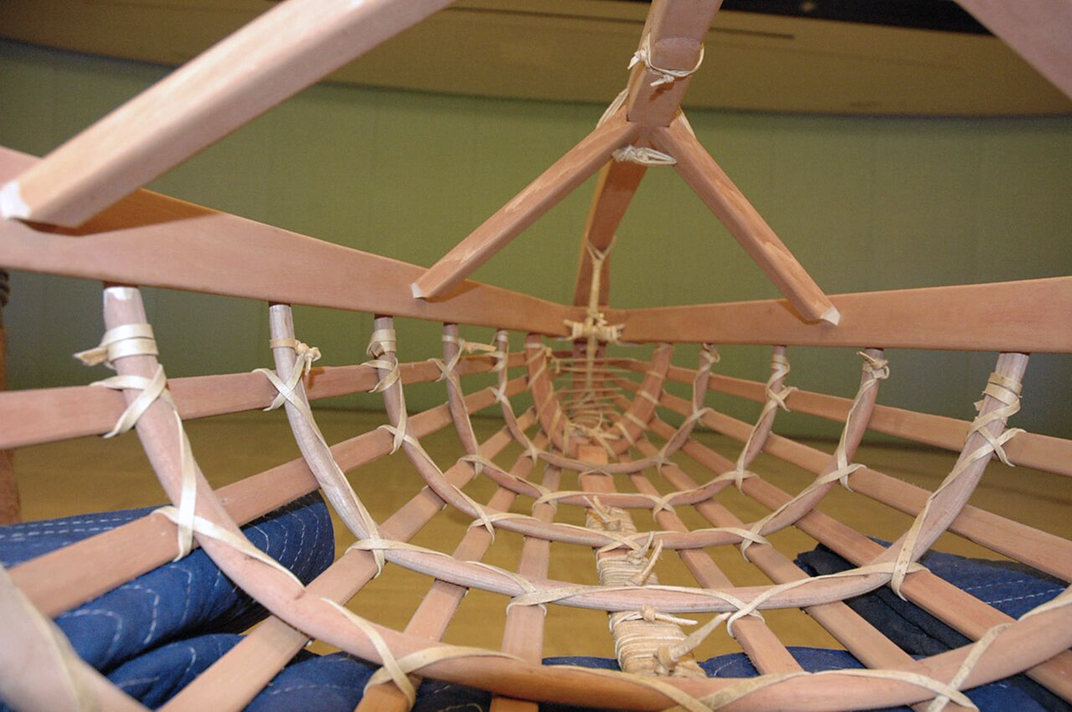
In New York, Duane expressed his fascination with kayak hunting, pointing out that each item a Yup'ik hunter uses is essential. On display in the exhibition Infinity of Nations is a Yup'ik hunting hat, part of the hunter’s efficient and balanced system. Duane explained that the hat not only shields the hunter’s face from the sun, but its conical shape amplifies the subtle echoes of the sounds made by seals and fish under the surface of the water. Bill emphasized that the tools of a Yup'ik hunter kept him alive, and since his kayak was custom-made for his body, it became an extension of his being.
For 13 years, Bill was the only apprentice to Frank Andrew and his vast knowledge of kayak-making. Many family members helped to translate countless questions from Bill to the ever patient Yup'ik elder, and Bill shared much of what he learned with his sons Troy and Ethan. From the time the new Qayak Center was built in 2000 until he passed away in 2006, Frank, with Bill's urging, expanded his training to a deeply authentic level for all four of his students. Bill recalled watching Frank Andrew speak with his son in Yup’ik, joking that the “DSL connection” between the two led Noah to perfect his skill in about a quarter of the time it took him. “I think we’ve been successful in creating a small but new generation of traditional kayak builders. And they can choose to go to schools or build them or pass them on, or not. But I’m off the hook now.
“I don’t want to be the last guy,” Bill explained. “This knowledge should be back in some Native hands. And we’ve done that, so I consider that kind of successful.”
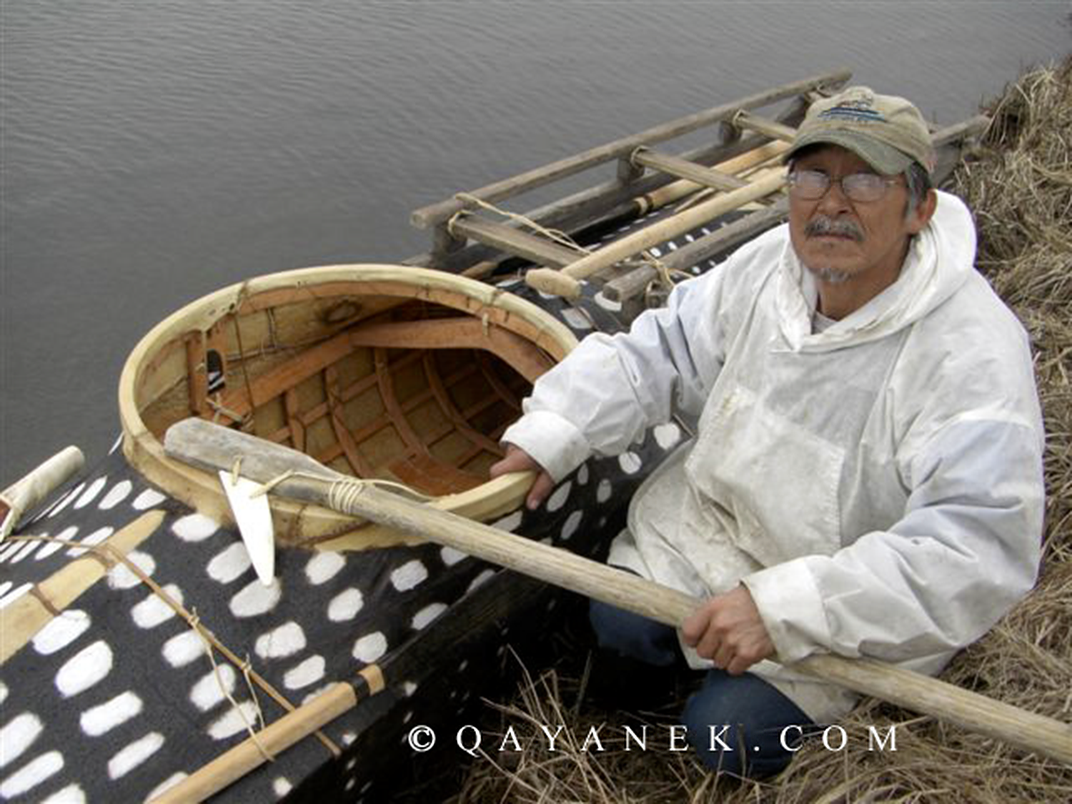
For Duane, from the first call to Kwigillingok in October 2015 to the arrival of the frame in February 2016, the experience was a complete adventure. The museum’s Mary Ahenakew and Gaetana DeGennaro happened upon the Qayanek website, and fate had it that Bill was willing to sell the frame. The four-hour time difference, mounds of paperwork, and 4,000 miles of distance pushed everything up to the wire, and a December 31 New York State Council on the Arts (NYSCA) grant deadline loomed at the horizon. Duane maintained weekly contact with Bill, sometimes even reaching him between classes he teaches at the local school in Kwig.
The request to buy from Bill was processed in Washington on December 23, eight days before the NYSCA grant deadline. People working on the project here in New York couldn’t help but be giddy. They regarded the last-minute victory as a “Christmas miracle,” a few even suggesting that none other than Santa Claus himself had agreed to ship the frame.
But what to do without Santa’s sleigh? “OK,” Duane remembered thinking to himself, “we’ve bought this thing. How are we gonna get it from Alaska to New York?” Bill’s experience finding a way to ship the enormous frame from tiny Kwig to New York was a true testament to the ambition and hard work of his family and the Kwigillingok community. The process he described echoed the sense of adventure that Duane felt on his end, yet was wrapped up in the difficulties of life in the Alaskan bush. Bill built an 18-foot, 700-pound custom shipping crate in the back aisle of their grocery store, which was the only indoor place it would fit. He and his son Ethan then had to disassemble it to get it out the door, reassemble it in a blizzard, and haul it a quarter of a mile through the same blizzard to the school. There, it was stored until the kayak was carefully secured and ready to begin its journey to the museum.
The final transport plan included movement on land, water, and sky. Bill stressed the danger associated with landing planes in the tiny Kwig airport, lightheartedly mentioning that “it’s very skinny, and it’s very short. . . . One pilot came out and landed on this airport, went back to Bethel, and said ‘I quit.’” The frame was flown from Kwigillingok to Bethel, and from Bethel to Anchorage. Then it was transferred to a steamship and rode the waves from Anchorage to Seattle, where it was picked up by a truck and driven to New York.
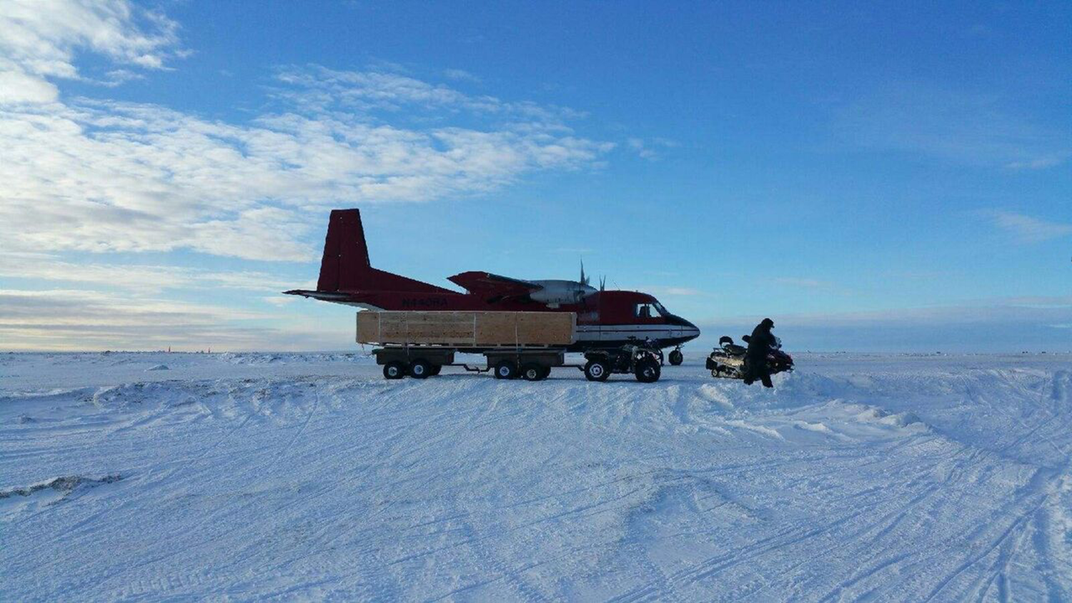
The frame arrived at the museum on Wednesday, February 3. Duane recounted that he had happened to call Bill to check in on the shipping status the day before and was astonished to hear that not only had the frame been shipped, it was set to be delivered the next day. With less than 24 hours to prepare for the arrival, the project team figured out all the logistics just in the nick of time. It was obvious that Bill took great care in packing the frame. He wrote detailed instructions on the wooden crate, complete with miniature drawings and little black circles that indicated which screws should be taken out first, as well as a playfully blunt warning: “Lid is very heavy! Do not drop lid into crate and crush contents.”
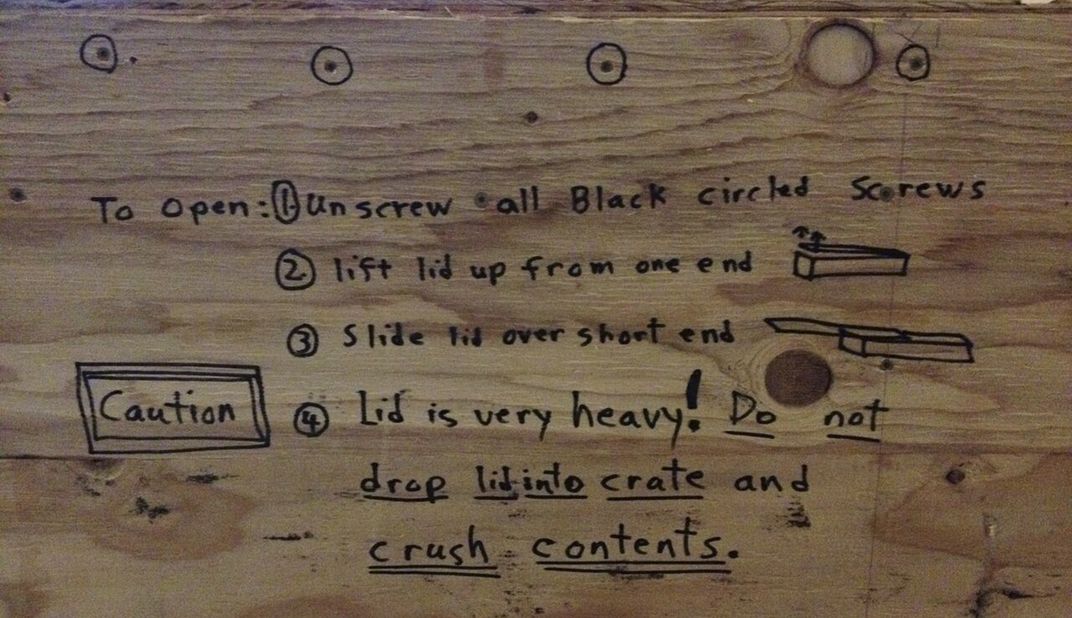
The breathtaking craftsmanship and simple beauty of the piece were obvious as soon as it was unpackaged. Duane held a blessing ceremony to welcome the frame into the space, acknowledging the time and hard work that went into the project and making sure to snap a picture for Bill to assure him that the frame arrived safely and in one piece.
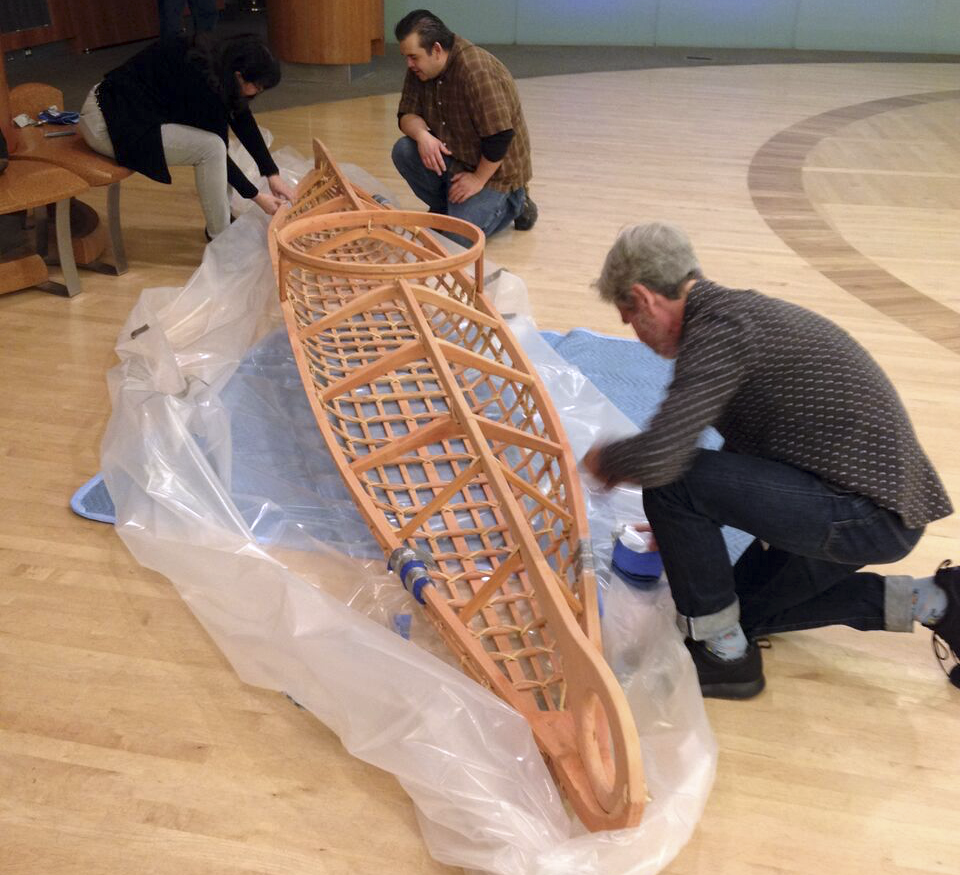
I asked Duane about the importance of obtaining authentic Native objects for the iAC. He replied that putting pieces like the kayak on display shows that “traditional methods and knowledge are still valid in the contemporary world.” Since the exhibition will focus on both the history and current use of Native innovations, it speaks to the integrity of the museum that so much time, effort, and stress were put into assuring that the kayak was not only culturally accurate, but produced in a Native environment, with traditional materials. Duane noted that, remarkably, commercial kayaks are still designed in an extremely similar way. “It still works!” he said. “The technology still works.”
The singular history of this kayak frame adds to a much larger conversation. Not only does the existence of the frame rely upon the ingenuity of the Native people who first designed it, it also hinges on the dedication of Frank Andrew, his family, and a new generation of builders who keep Frank's legacy alive and believe in the value of tradition and learning through experience. The story of this kayak adds to a broader narrative of cultural exchange and conservation, and the importance of institutions like the museum that work to preserve the memory of Native innovation, as well as support its modern reality. Ultimately, the kayak will serve as a jumping off point for young people who will leave the museum with a deeper and more personal understanding of the lasting impact of Native knowledge and design, and an interest in learning more.
As a middle school teacher, Bill has hands-on experience with the impact that Native history and knowledge have on today’s younger generations. Since the kayak frame will eventually be housed in the iAC here in New York, I asked Bill for his view on the importance of displaying Native objects in educational settings. “Here’s why I think it’s important to young people,” he said with obvious passion. “When they see the genius of kayak building, they realize that they are a part of a culture that is just as smart, just as brilliant, just as innovative, as any other society. Everybody needs to know their own self-worth, their own cultural self-worth. We all have a place in the existence of humanity, and we should all be considered with equal respect and dignity and knowledge. And I think that that’s a really important aspect of teaching people, Native and non-Native, about the brilliance of kayak-building.”
